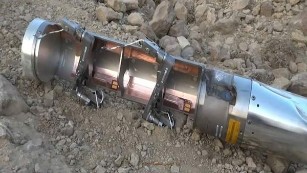By Ben Brumfield and Slma Shelbayah
Human Rights Watch has accused Saudi Arabia of dropping U.S.-supplied cluster bombs in the fight against Houthi rebels in Yemen.
The small bombs, if unexploded, can lay dormant and then detonate when people stumble upon one by chance, killing or maiming them as a result.
An international treaty against cluster bombs has been adopted by 116 countries, but the United States, Saudi Arabia and Yemen are not among them.
The particular cluster munition systems HRW said were used are CBU-105 Sensor Fuzed Weapons, which are guided bombs intended to take out tanks and other armored vehicles with a flurry of explosions spread out over an area.
If the cluster bombs fail to detect their target, they are designed to self-destruct in the air, or if that fails, to deactivate themselves after a short time. But sometimes those mechanisms don't work, posing a lethal danger for those who later encounter them.
Saudi Arabia has denied there are any coalition forces in Yemen and says there are only Yemeni forces that Saudi Arabia is supporting, according to Brig. Gen. Ahmed Asiri, a Saudi military spokesman. He told CNN Saudi Arabia has been using CBU-105 in Yemen against armored vehicles and not in the city.
"There is no foreign fighters in Yemen, so far," Asiri told CNN on Sunday.
Asiri also criticized the Human Rights Watch organization on how it obtains information, saying it is getting it from Houthi militia.
"The (HRW) report itself defines the 105 as anti-vehicle weapons. We do not use it against persons. We don't have any operation in the cities. So the allegation which is in the report it is, I think it is not so solid."
CNN tried to contact officials in Washington for comment on the HRW report allegations but there was no immediate response.
Human Rights Watch included video, marked-up satellite maps and photos in its report.
The video shows delivery devices falling from the sky by small parachutes then deploying its bombs with a burst of black smoke in midair. Shallow explosions spread over areas on the ground below. The images were shot by pro-Houthis in April, HRW said.
Photos show working parts of the deployment system on the ground.
The U.S. Department of Defense has said it will stop the transfer to foreign governments of cluster munitions that leave behind more than 1% of their bombs unexploded -- but not until after 2018.
"Saudi-led cluster munition airstrikes have been hitting areas near villages, putting local people in danger," Steve Goose, the director of HRW's arms division, said in a statement. "These weapons should never be used under any circumstances."
The human rights activists say the cluster munitions were dropped over northern Saada governorate, a Houthi rebel stronghold near Saudi Arabia. The satellite map shows the target area in the mountains above the villages of al-Ssam and al-Safraa.
About 5,000 people live in al-Safraa in times of peace, HRW said.
The Houthis are Shiite Muslims aligned with Iran who have long clashed with Yemen's central government. Over the past seven months, they have overrun Yemen's capital, ousted its President and seized control of other parts of the country well beyond their northern power base.
Saudi Arabia is a majority Sunni country that has viewed the Houthis' rise with alarm, fearing that unrest in Yemen could spread across their border or lead to bitter rival Iran establishing a foothold on the Arabian Peninsula.
The overthrown Yemeni government, whose President is now in exile, was allied with the West in the fight against al Qaeda in the Arabian Peninsula (AQAP). The Houthis are also foes of AQAP, which has sought to take advantage of the deepening chaos in Yemen.


No comments:
Post a Comment